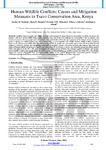Human-Wildlife Conflicts: Causes and Mitigation Measures in Tsavo Conservation Area, Kenya

View/
Date
2014Author
Makindi, Stanley M.
Mutinda, Mark N.
Olekaikai, Nicholas K.W.
Olelebo, Wilson L.
Aboud, Abdillahi A.
Metadata
Show full item recordAbstract
Conflicts between people and wildlife currently rank amongst the main threats to conservation in Africa. In Kenya, for instance, with much of the wildlife living outside protected areas, one of the real challenges to conservation is how to enhance and sustain co-existence between people and wild animals. It is undoubtedly evident that the expansion of the human society has forced people to infringe on wildlife habitats and convert land to other uses incompatible with wildlife. Human-wildlife conflicts negatively impact on the humans and wildlife alike. An understanding of how the people and conservation agents deal with the problem of wildanimals is critical in evolving and establishing sustainable conservation systems. This article presents and analyses data from case studies of human-wildlife interactions in Tsavo Conservation Area (TCA) in Kenya. A survey was conducted among households sampled within and adjacent to the TCA. The study investigated the causes and mechanisms and strategies applied to mitigate and manage human-wildlife conflicts and provide long-term solution to the prevalent resource use conflicts around and within TCA. The findings suggest the need to address the issue of human-wildlife conflict in the context of sustainable conservation practice through a combination of indigenous and conventional rationales to demonstrate that wildlife can co-exist with people
